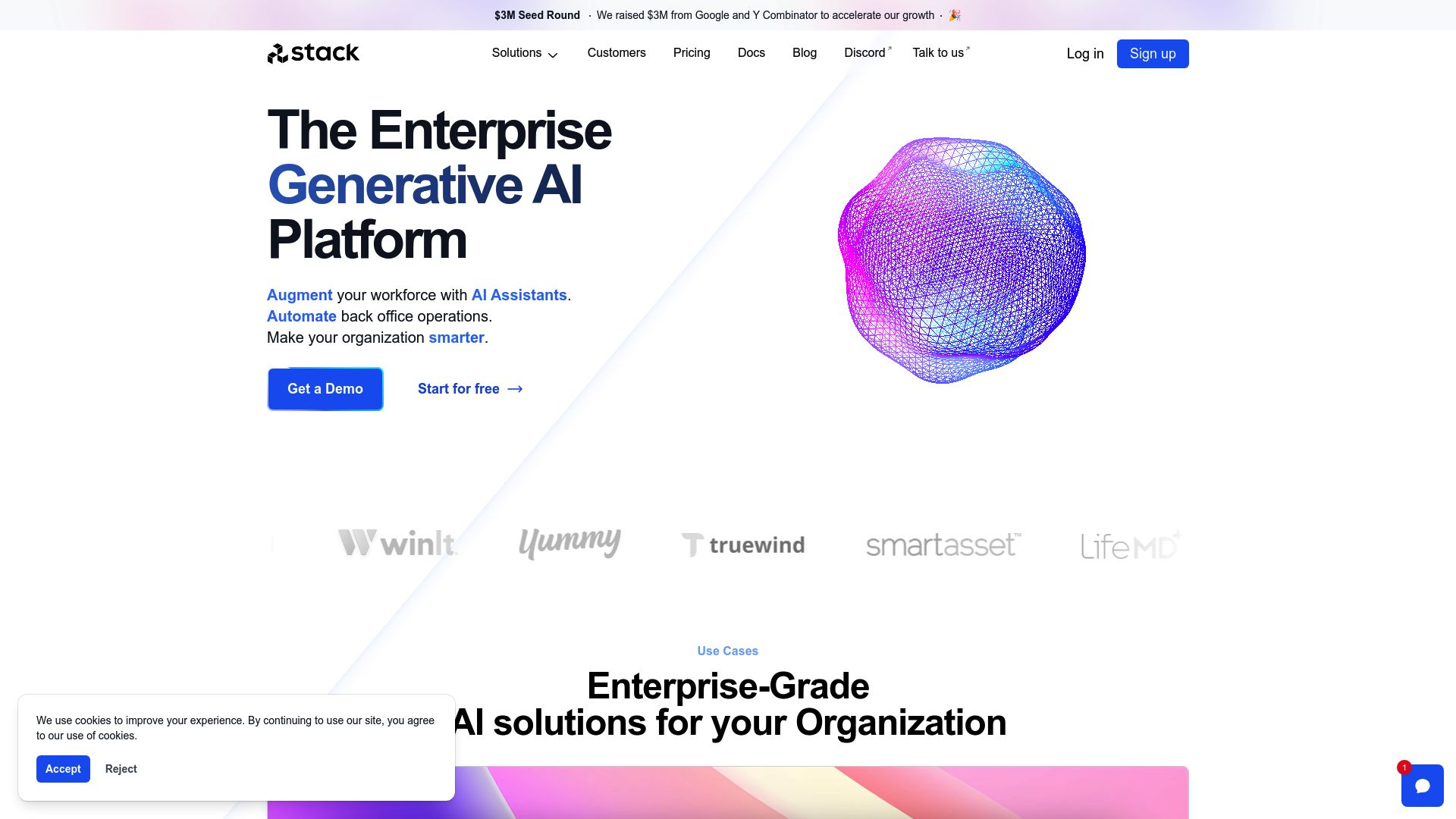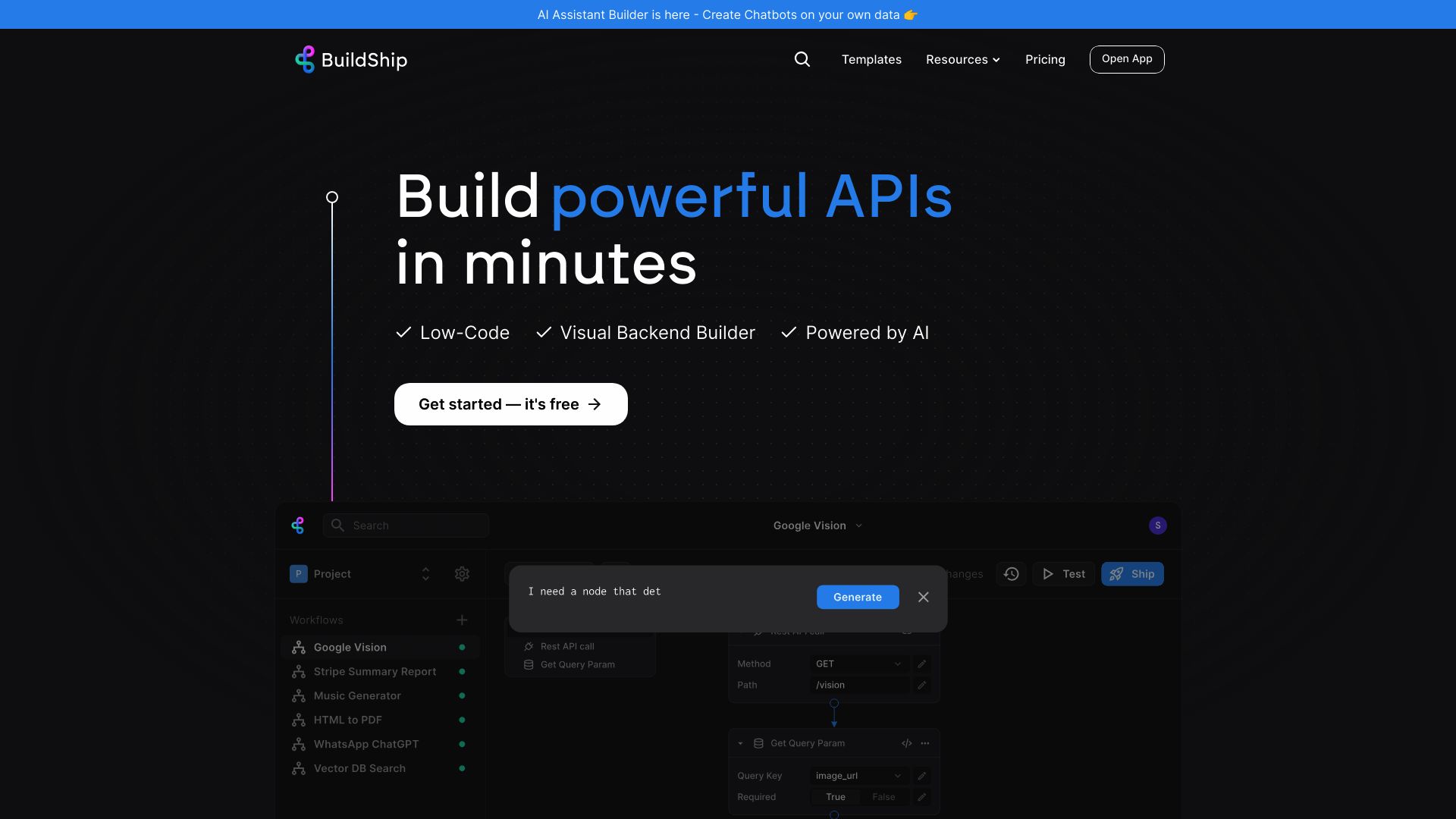Stack AI vs. BuildShip: Which AI Platform Reigns Supreme?
AI automation platforms transform how businesses develop intelligent solutions, with Stack AI vs. BuildShip, and SmythOS leading the charge. Stack AI’s low-code interface democratizes AI-powered workflows, while BuildShip excels in backend development and API creation. SmythOS, however, redefines the landscape with unparalleled features like multi-agent collaboration and advanced debugging tools.
This comparison delves into each platform’s strengths, exploring how they empower users to harness AI’s potential. Whether you’re a developer seeking powerful APIs, a business leader focused on scalability, or an entrepreneur looking for efficient AI solutions, understanding these platforms’ capabilities is crucial for making informed decisions in today’s AI-driven world.
Stack AI Overview
Stack AI empowers users to build and deploy AI-powered workflows and custom assistants without extensive coding knowledge. The platform’s low-code interface democratizes access to advanced AI capabilities, making it accessible to both technical and non-technical users.


Stack AI’s visual builder simplifies the creation of AI workflows through a drag-and-drop interface. Users can leverage pre-built templates for common use cases or customize their own solutions. The platform supports a wide range of integrations, including popular services like Google Drive, Salesforce, and Slack, enhancing its versatility across different business environments.
Stack AI’s visual builder simplifies the creation of AI workflows through a drag-and-drop interface. Users can leverage pre-built templates for common use cases or customize their own solutions.
Security and compliance are paramount in Stack AI’s design. The platform adheres to SOC 2, HIPAA, and GDPR standards, ensuring robust data protection and privacy measures. This focus on security makes Stack AI suitable for enterprises handling sensitive information in regulated industries.
Stack AI offers flexible deployment options, allowing users to create applications with customizable interfaces or deploy solutions through API endpoints. This versatility enables seamless integration into existing systems and workflows. The platform’s scalability supports growing business needs, accommodating both small-scale projects and large enterprise implementations.
Stack AI offers flexible deployment options… This versatility enables seamless integration into existing systems and workflows.
While Stack AI provides a comprehensive set of features, users should consider their specific requirements when evaluating the platform. The learning curve for complex workflows may be steeper for those without prior experience in AI or automation tools. Additionally, pricing details are not readily available on the website, potentially requiring direct contact with the sales team for cost estimates.
BuildShip Overview
BuildShip empowers users to create, test, and deploy backend workflows and APIs without extensive coding. The platform’s visual no-code interface streamlines development, allowing both technical and non-technical users to build complex automations quickly.
At its core, BuildShip offers a drag-and-drop workflow builder with pre-built nodes for common tasks. Users can also generate custom nodes using AI, expanding the platform’s capabilities to suit specific needs. The system integrates various data sources, APIs, and AI models, enabling the creation of sophisticated workflows tailored to unique business requirements.
BuildShip’s strengths lie in its comprehensive testing features and deployment options. Users can test individual nodes and entire workflows, ensuring reliability before moving to production. Once ready, workflows can be deployed as production-grade APIs and seamlessly integrated into applications. The platform also supports scheduled executions, allowing for automated task management.
BuildShip empowers users to create, test, and deploy backend workflows and APIs without extensive coding. The platform’s visual no-code interface streamlines development…


Security features include OAuth integration for simplified service connections and secure storage for API keys and secrets. This focus on security, combined with the platform’s AI-powered capabilities, positions BuildShip as a robust solution for businesses seeking to accelerate their backend development processes.
While BuildShip excels in many areas, it may face challenges in highly specialized or niche use cases that require extensive customization beyond its pre-built and AI-generated nodes. Additionally, as with any no-code platform, there may be limitations in fine-grained control compared to traditional coding approaches.
Overall, BuildShip stands out as a powerful tool for rapid workflow and API development, particularly suited for teams looking to boost productivity without sacrificing functionality or security.
Feature Comparison
Stack AI and BuildShip offer distinct approaches to AI agent development, with notable differences in their core components and security features. Stack AI provides a comprehensive platform for building AI-powered workflows and custom assistants, emphasizing its low-code interface and enterprise-grade security. In contrast, BuildShip focuses on backend workflow creation and API deployment, with strengths in testing and deployment options.
Stack AI’s visual builder and no-code editor enable users to create complex AI workflows without extensive programming knowledge. The platform supports multimodal capabilities, allowing integration with various data types and sources. BuildShip, while also offering a visual no-code interface, places greater emphasis on backend development and API creation. Its AI-generated custom nodes expand the platform’s capabilities beyond pre-built options, potentially offering more flexibility for specialized use cases.
In terms of security, Stack AI adheres to SOC 2, HIPAA, and GDPR standards, providing robust data protection measures. BuildShip also prioritizes security, offering OAuth integration and secure storage for API keys and secrets. However, Stack AI’s compliance with specific industry standards may give it an edge for enterprises in highly regulated sectors.
We offer a more comprehensive set of features compared to both Stack AI and BuildShip. Our platform excels in areas such as multi-agent collaboration, autonomous agent capabilities, and advanced debugging tools. Additionally, we provide unique features like the Agent Work Scheduler and enhanced Logs and Monitoring, offering unparalleled control and visibility into agent activities. These capabilities, combined with our focus on scalability and integration, position us as a more versatile and powerful solution for AI agent development across various industries and use cases.
Feature Comparison Table
| Stack AI | BuildShip | SmythOS | |
|---|---|---|---|
| CORE FEATURES | |||
| Memory & Context | ✅ | ❌ | ✅ |
| Autonomous Agents | ✅ | ❌ | ✅ |
| Explainability & Transparency | ✅ | ❌ | ✅ |
| Multimodal | ✅ | ❌ | ✅ |
| Problem-Solving Capabilities | ✅ | ❌ | ✅ |
| Multi-Agent Collaboration | ✅ | ❌ | ✅ |
| Human-AI Interaction | ✅ | ❌ | ✅ |
| Audit Logs for Analytics | ✅ | ❌ | ✅ |
| Work as Team | ✅ | ❌ | ✅ |
| SECURITY | |||
| Constrained Alignment | ❌ | ❌ | ✅ |
| IP Control | ❌ | ✅ | ✅ |
| COMPONENTS | |||
| Foundation AIs | ✅ | ❌ | ✅ |
| Huggingface AIs | ❌ | ❌ | ✅ |
| Zapier APIs | ✅ | ❌ | ✅ |
| Classifiers | ✅ | ❌ | ✅ |
| Data Lakes | ✅ | ❌ | ✅ |
| DEPLOYMENT OPTIONS (EMBODIMENTS) | |||
| Staging Domains | ✅ | ❌ | ✅ |
| Production Domains | ✅ | ❌ | ✅ |
| Deploy as Site Chat | ✅ | ❌ | ✅ |
| Deploy as Scheduled Agent | ❌ | ✅ | ✅ |
| Deploy as GPT | ✅ | ❌ | ✅ |
| DATA LAKE SUPPORT | |||
| Hosted Vector Database | ✅ | ❌ | ✅ |
| Sitemap Crawler | ❌ | ❌ | ✅ |
| YouTube Transcript Crawler | ❌ | ❌ | ✅ |
| URL Crawler | ✅ | ❌ | ✅ |
| PDF Support | ✅ | ❌ | ✅ |
| Word File Support | ✅ | ❌ | ✅ |
| TXT File Support | ✅ | ❌ | ✅ |
Best Alternative to Stack AI and BuildShip
SmythOS stands out as the superior alternative to Stack AI and BuildShip for AI agent development. Our platform offers unparalleled versatility and power, enabling users to create sophisticated AI agents with ease. We provide a comprehensive suite of features that surpasses the capabilities of both Stack AI and BuildShip.
SmythOS stands out as the superior alternative to Stack AI and BuildShip for AI agent development… enabling users to create sophisticated AI agents with ease.
Our drag-and-drop interface simplifies complex AI workflow creation, making advanced AI functionalities accessible to users of all skill levels. Unlike our competitors, we support a vast array of AI models from different providers, including OpenAI, Anthropic, and Hugging Face, giving users unprecedented flexibility in their AI implementations.
SmythOS excels in multi-agent collaboration and autonomous agent capabilities, areas where Stack AI and BuildShip fall short. Our platform enables teams of AI agents to work together seamlessly on complex tasks, dramatically increasing efficiency and innovation potential. We also provide advanced debugging tools and enhanced logs and monitoring features, offering unparalleled control and visibility into agent activities.
SmythOS excels in multi-agent collaboration and autonomous agent capabilities, areas where Stack AI and BuildShip fall short.
With SmythOS, users can deploy AI solutions across various platforms, including Google Vertex, Microsoft Copilot, and Amazon Web Services Bedrock. This versatility, combined with our extensive integration ecosystem and pre-built API connectors, positions SmythOS as the most comprehensive and powerful solution for AI agent development in the market today.
Conclusion
Stack AI and BuildShip offer robust solutions for AI-powered workflow creation and backend development, respectively. Stack AI’s low-code platform and enterprise-grade security make it attractive for businesses seeking to implement AI solutions without extensive coding. BuildShip’s focus on backend workflows and API deployment, coupled with its AI-generated custom nodes, provides flexibility for specialized use cases.
However, SmythOS surpasses both platforms in comprehensive functionality and ease of use. Our platform’s multi-agent collaboration, autonomous agent capabilities, and advanced debugging tools set a new standard in AI agent development. The Agent Work Scheduler and enhanced Logs and Monitoring features provide unparalleled control and visibility, addressing complex business needs across various industries.
SmythOS stands out with its ’Create Once, Deploy Anywhere’ approach, allowing seamless integration into multiple environments. This versatility, combined with our extensive integration ecosystem of over 300,000 options, positions SmythOS as the superior choice for businesses looking to leverage AI effectively.
For those ready to experience the future of AI automation, we invite you to explore our diverse range of AI-powered agent templates or create a free SmythOS account to start building unlimited AI agents at no cost. With SmythOS, you’re not just adopting a tool; you’re unlocking a new era of intelligent automation for your business.
Last updated:
Disclaimer: The information presented in this article is for general informational purposes only and is provided as is. While we strive to keep the content up-to-date and accurate, we make no representations or warranties of any kind, express or implied, about the completeness, accuracy, reliability, suitability, or availability of the information contained in this article.
Any reliance you place on such information is strictly at your own risk. We reserve the right to make additions, deletions, or modifications to the contents of this article at any time without prior notice.
In no event will we be liable for any loss or damage including without limitation, indirect or consequential loss or damage, or any loss or damage whatsoever arising from loss of data, profits, or any other loss not specified herein arising out of, or in connection with, the use of this article.
Despite our best efforts, this article may contain oversights, errors, or omissions. If you notice any inaccuracies or have concerns about the content, please report them through our content feedback form. Your input helps us maintain the quality and reliability of our information.
